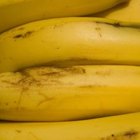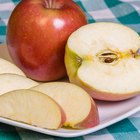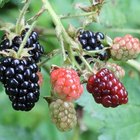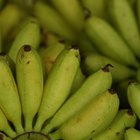
Murphy_Shewchuk/iStock/Getty Images
When fully ripe, “Red Delicious” apples (Malus domestica “Red Delicious”) are a luscious red, with white flesh, a crisp texture and a sweet taste. Grown commercially and in home gardens, Red Delicious apples are best eaten fresh and are not ideal for cooking. They grow well in U.S. Department of Agriculture plant hardiness zones 4 through 7. Picking Red Delicious apples at just the right time will ensure a juicy, crisp tart treat.
Timing and Hardiness Zones
Red Delicious apples are mature 135 to 155 days after the trees produce blossoms in the spring. This means that you can usually harvest ripe Red Delicious apples from late August to October. But local weather conditions, including the hardiness zone your growing area falls into, will affect the harvest time for your fruits. Warmer climates will have a slightly earlier harvest period, while cooler ones will have a later harvest period. Begin checking for rip apples early to mid-August to be on the safe side.
Signs of Ripeness
While redness is a generally a sign of ripeness, with Red Delicious apples, this cue can be misleading. This variety turns red long before they are fully ripe. Red Delicious apples will fall to the ground when they have already been ripe for several weeks. Apples that have fallen to the ground are still edible, and this is a good indicator that other apples are ready to harvest. Red Delicious apples should still feel firm when harvested -- softness is a sign of being overripe. Fully ripe Red Delicious apples will separate easily from the tree, and the flesh will be fully white, with no green tinge. To harvest properly so you do not damage the spur or fruit, grasp the apple in your hand and pull upwards on it and then outwards, giving a slight twist as you pull. Red Delicious apples will continue ripening after harvest.
Early Harvest and Storage
Red Delicious apples, like other apples, are storage hardy. They stay good for a long time after they have been picked, as the fruit is able to survive on starch it has saved up during the growing period. To ensure long storage times, harvest the apples with their stems. Fruit with attached stems store longer. To ensure you do not have overripe apples, and to avoid bruised fruit since dropped fruit can become damaged, harvest Red Delicious apples a little early in the season and allow them to ripen off the tree. For long-term storage, keep in a cool, well-ventilated area, roughly 32 degrees Fahrenheit in a high-humidity environment. Red Delicious apples can be stored in cool temperatures for three to four months.
Encourage Ripening
Apples release ethylene gas as they ripen, so they encourage other fruits and vegetables, as well as other apples, to ripen faster. To encourage ripening, store apples together in a closed paper bag at room temperature for a few days. The enclosed space will trap the ethylene gas, encouraging ripening. As apples mature, their flesh becomes softer -- a characteristic you can test by gently pressing an apple with your thumb and fingers. The more give there is, the more mature the apple.
Related Articles

Stages of a Ripening Banana
When Is Grapefruit Season in Florida?

Why Do Banana Peels Turn Brown?

How to Freeze Apples With Lemon Juice

How to Preserve Fresh Apples

How to Soften Tomatoes

How to Dry Pineapple in a Dehydrator

How Fast Does it Take for Apples to Rot?

When to Harvest Sweet Meat Squash?

Can You Peel and Refrigerate Bananas ...

How to Take Care of Raspberry Bushes

How to Ripen Blackberries

What Makes Strawberries Taste Sour?

Is Eating a Banana With Brown Spots Bad ...

How to Keep Pomegranate Fresh
How Long Is it Safe to Keep Frozen ...
Does Baking Soda Prevent Apples from ...

How Can I Preserve Peaches Without ...

How to Prevent Bananas From Browning ...

Types of Quince Trees
References
- Ontario Ministry of Agriculture, Food and Rural Affairs: Evaluating Maturity of McIntosh and Red Delicious Apples
- University of Wisconsin: When Are Apples Ripe?
- North Carolina State University: Growing Apple Trees in the Home Garden
- Texas A&M: Apples
- Oregon State University: How to Tell When Your Apples Are Ripe
- Purdue University: Home Storage of Apples
Writer Bio
Benjamin Shorter has been a writer for publications such as the "New Brunswick Telegraph-Journal," "National Post" and the "Edmonton Journal" since 2001. He holds a Bachelor of Arts in history from McGill University, a Master of Arts in history from Central European University and a diploma in journalism from Concordia University.
Photo Credits
Murphy_Shewchuk/iStock/Getty Images